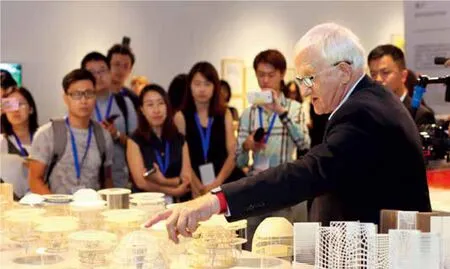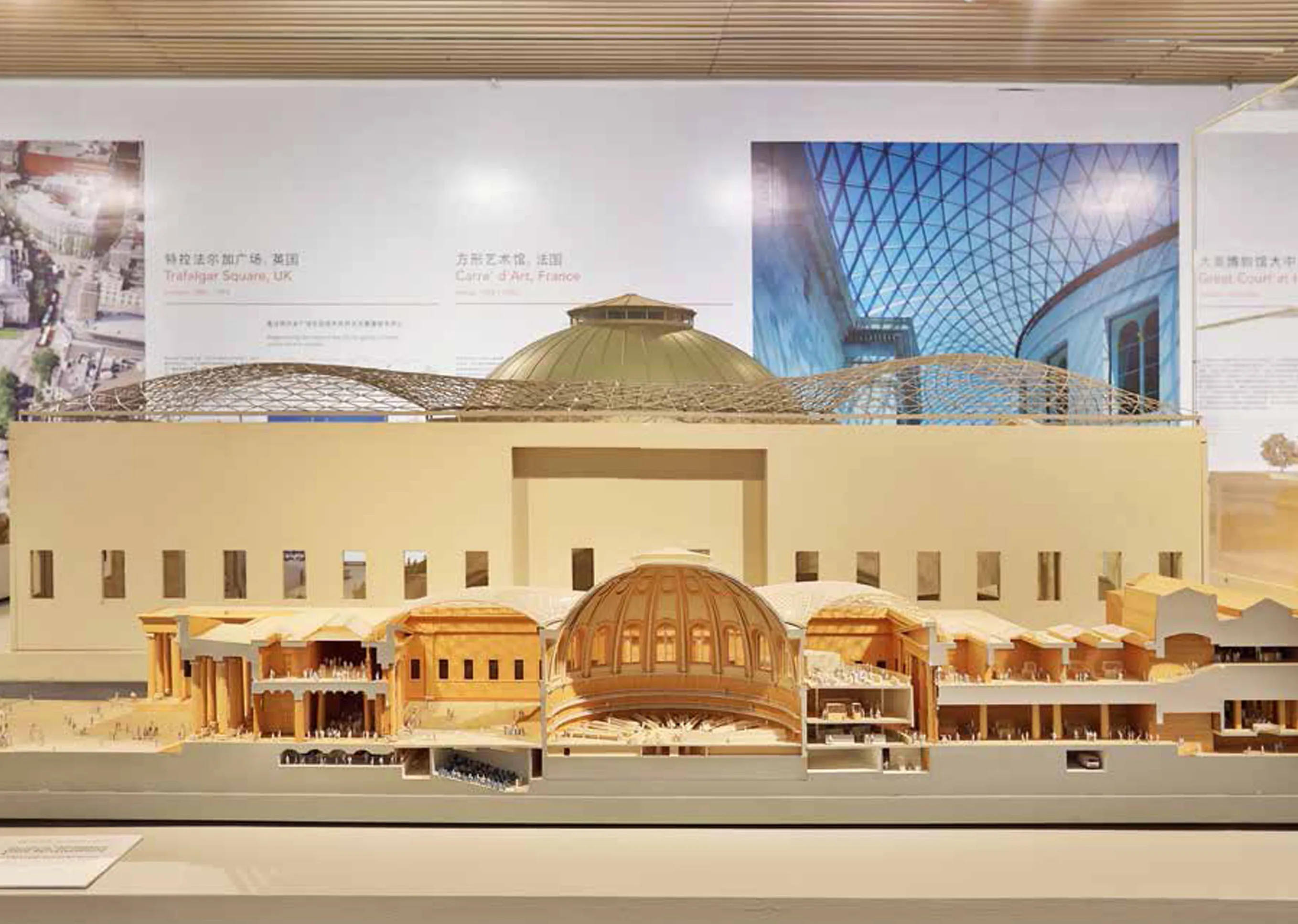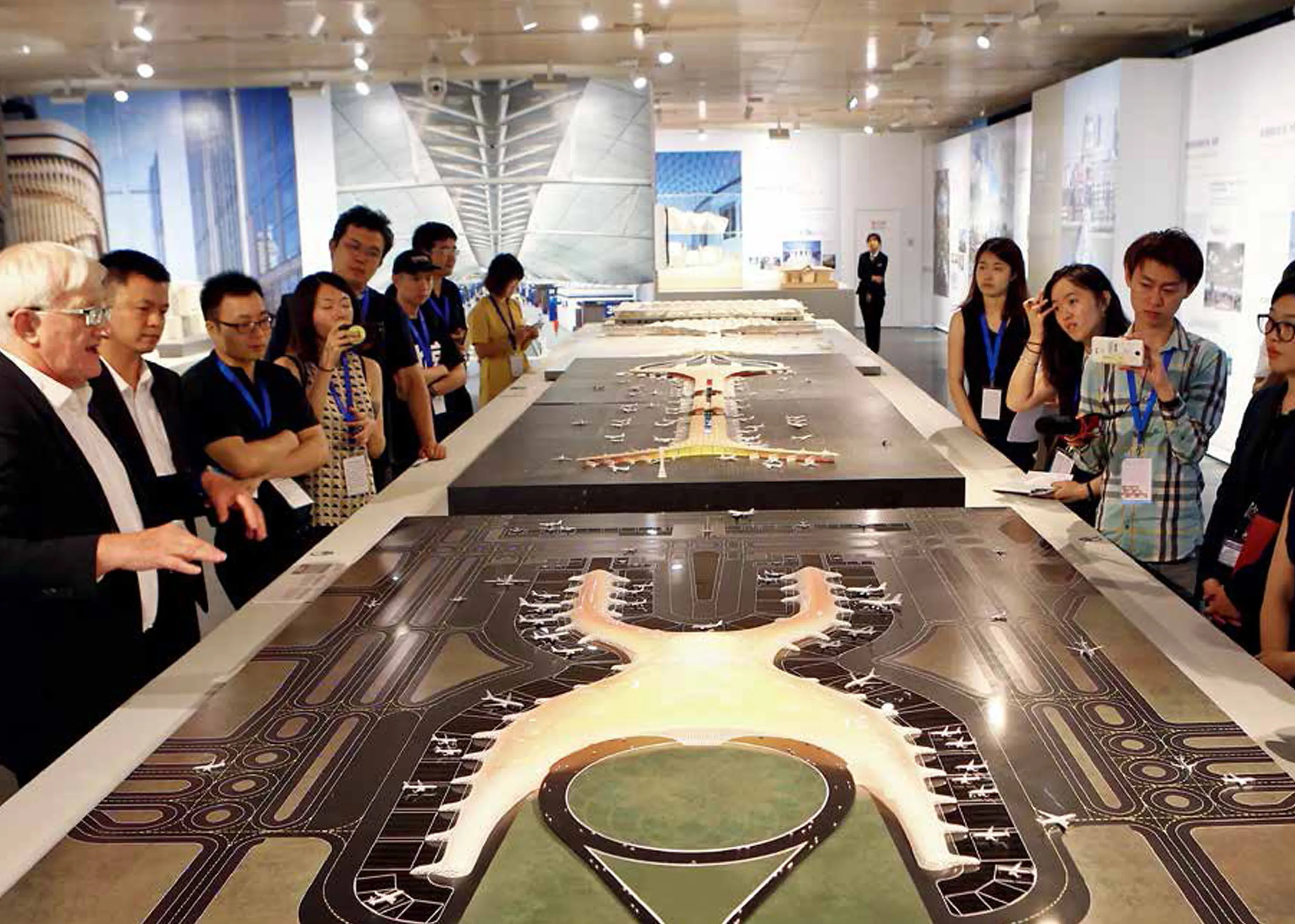格雷·說城市
2018年7月24日,由英國福斯特及合伙人建筑設(shè)計(jì)事務(wù)所“可持續(xù)人居|共享的未來”展覽在清華大學(xué)藝術(shù)博物館開幕(圖1—圖4)。斯賓塞·德·格雷先生接受了本刊記者專訪。
Q1智慧城市建設(shè)中如何體現(xiàn)城市設(shè)計(jì)的作用?
我認(rèn)為城市設(shè)計(jì)包含很多方面的特點(diǎn),也具有很多要素。例如宜居的城市空間既要有智慧城市的技術(shù)要素,又要有一定的創(chuàng)造性要素。它們之間有一個平衡點(diǎn),我們應(yīng)當(dāng)非常謹(jǐn)慎地尋找到兩者之間的平衡點(diǎn)。因?yàn)槿绻渲幸环N方法以犧牲另一種方法為代價占了上風(fēng),那么另一種方法就沒有完美的解決方案。所以我認(rèn)為,探索空間本質(zhì)是非常必要的,無論建筑之間還是廣場和街道,這在任何城市都很重要。這些空間的質(zhì)量如何?它們到底是不是好的空間?
這說起來很容易,但實(shí)現(xiàn)起來要困難得多。所以,在開始設(shè)計(jì)工作之前,我們要對這些空間進(jìn)行足夠的分析,了解人們?nèi)绾卧诳臻g中移動,了解日照的質(zhì)量或是缺少日照的狀況,了解建筑的朝向、地區(qū)的風(fēng)向等。所有這些可以客觀分析的品質(zhì)對于一個成功的設(shè)計(jì)來說是非常重要的。在此基礎(chǔ)上提出智慧城市才是正確的,將智慧技術(shù)整合到城市肌理中也是非常重要的。
這包括,使用電動汽車而不是耗油量大的汽車,管理行人和車輛之間的關(guān)系等,使城市設(shè)計(jì)對能源和環(huán)境的影響找到新的平衡。也就是說,城市設(shè)計(jì)是一個非常復(fù)雜的問題,這也正是我們派出一個強(qiáng)大的城市設(shè)計(jì)團(tuán)隊(duì)來應(yīng)對每個城市設(shè)計(jì)項(xiàng)目的原因。但如果不將智能技術(shù)的相關(guān)方面整合到當(dāng)前的城市設(shè)計(jì)中,那就太瘋狂了。因此,我認(rèn)為這是一個在兩者之間取得平衡并以一種成功方式整合它們的問題。
Q2在城市可持續(xù)發(fā)展的過程中,城市設(shè)計(jì)對保護(hù)和傳承歷史文化具有什么樣的作用?
我們一直很感興趣的主題之一就是新舊關(guān)系。我認(rèn)為一個成功的城市設(shè)計(jì)是尊重過去的,但絕不是在舊的上面束縛手腳,而是在過去的基礎(chǔ)上進(jìn)行建造。一些事件會影響了過去的空間,特別是比較近的過去,那么引入新的元素,建立在舊的空間之上,并把空間變成更新的當(dāng)代城市的一部分。
我總是談?wù)撘3制胶狻H绻^去是值得保留,那么忽視它就是瘋狂之舉。建立在過去的基礎(chǔ)上,引入新的元素,為特定的片區(qū)或街道或各種場所帶來新的生活。這種原則對于歷史建筑來說同樣成立,我們對建筑和城市設(shè)計(jì)采取完全一樣的態(tài)度和做法。

圖1 / Figure 1 2018年7月24日,斯賓塞·德·格雷先生在清華大學(xué)藝術(shù)博物館進(jìn)行導(dǎo)覽Mr. Spencer de Grey in Tsinghua University Art Museum,Beijing, China, July 24, 2018來源 / Source: Foster + Partners
Q3針對中國當(dāng)前的城市發(fā)展?fàn)顩r,您對開展城市設(shè)計(jì)有何建議?
中國的城市發(fā)展得很快,人們也有很多想法。如果你做錯了,你就會花很多錢,而不能為居住在那個地區(qū)和工作在那個地區(qū)的居民投資來改善他們的環(huán)境。我認(rèn)為這很有趣,并且我認(rèn)為人們對我們之前所說的一切都很感興趣。對我來說,這樣的問題一遍一遍地強(qiáng)化,那就是當(dāng)我在城市里散步時,我所經(jīng)歷的是什么樣的環(huán)境?如果你和這個房間里的人交談,談起他們真正喜歡散步的環(huán)境,大概是兩旁有四至六層建筑的街道,那里有熱鬧的商店、咖啡廳、餐館、文化設(shè)施、街頭茶座。
這樣的空間就是一個居住空間和辦公空間的豐富組合,我認(rèn)為這是一個很好的起點(diǎn),一個大的城市場景的橫截面。如果人們說:“我們要把這個街區(qū)變成住宅區(qū),把那個街區(qū)變成辦公樓,把那個街區(qū)變成購物區(qū)”,一切都劃分開了,那么這個場景就變味了。我認(rèn)為城市,無論在中國、在歐洲或是在其他的地方,在那些歷史悠久、充滿活力的城市中,你不能把這些功能區(qū)分開,它們都是混合在一起的,這樣人們才能去享受。他們可以去一家商店樓上的一間辦公室,然后再進(jìn)入公寓上面一個商店,等等。
當(dāng)這些都交織在一起的時候,我認(rèn)為這就形成了一個很好的起點(diǎn),并且我認(rèn)為這些問題需要非常仔細(xì)地討論,這也是一項(xiàng)艱巨的任務(wù)。每個城市都應(yīng)該有一個完整的系統(tǒng),你要類比不同的城市,并明白是什么讓這個城市運(yùn)轉(zhuǎn)起來。通過回溯歷史,了解這個城市是如何演變,那些街道和商店是怎樣形成的,等等,并從中學(xué)習(xí)。研究所有這些東西以及思考如何把這些東西轉(zhuǎn)換成另一種對象,這就是城市設(shè)計(jì)應(yīng)該做的工作。
的確,現(xiàn)在我們面臨一個積極的環(huán)境。在中國和世界各地,智能城市正開始變成一種潮流。高樓大廈往往只是落在街道網(wǎng)格上,人們說這就夠了。但這些城市與紐約是不同的,那里有適當(dāng)?shù)慕值溃歇?dú)立的建筑,有更多的空間。所以空間有可能性,它存在于一切事物中,那里到處都是高密度的。因此,如果我們試圖填滿這個強(qiáng)大的城市,我認(rèn)為人們不得不對這些問題提出質(zhì)疑。
如果建筑有四到五層樓高,就會產(chǎn)生更多好的空間。它們被非常仔細(xì)的組織,它們的高度提供了最大的陰影。街道很狹窄,但除了街道以外,顯然也有步行區(qū)域和廣場。與此同時,我們在高速公路上使用了一系列的高科技,并對更多的城市空間進(jìn)行了改造。這將給城市帶來一系列新的優(yōu)勢,再加上向中國傳統(tǒng)城市空間最好的方面進(jìn)行學(xué)習(xí),并將它們結(jié)合在一起。
在某種意義上這將形成一種不同的新模式,它與歷史的內(nèi)容密切相關(guān),并與優(yōu)秀的當(dāng)代設(shè)計(jì)聯(lián)系在一起。我認(rèn)為這兩者之間沒有沖突。我認(rèn)為你可以把這些元素混合在一起,這一定是非常不可思議的,我想我們會設(shè)計(jì)出很多更好的空間。建筑的未來也會從很多想法中浮現(xiàn)出來,但直到你開始談?wù)摻ㄖ旧恚艜兊锰貏e。解決方案是否與問題契合?顯然,畫出一幅圖景是很容易的。所以我仍然認(rèn)為,探討這些問題是非常重要的。
ORIGINAL TEXTS IN ENGLISH
[U-TALK]
Spencer de Grey·TALK about City
[Interviewee]Spencer de Grey
[Date]July 24, 2018
[Place]Beijing, China
[Interviewer]YANG Tao, SHANG Qian
Spencer studied at Cambridge University, joining the practice in 1973. He set up Foster + Partners' Hong Kong office in 1979 for the Hongkong Bank project,returning in 1981 to work on Stansted Airport and the Sackler Galleries at the RA. Since then he has worked on a wide range of cultural, civic, education and masterplan projects, including the Great Court, the Sage and MFA Boston. He is visiting Professor of Design at Cambridge University and a Royal Academician.
He is a visiting professor of design at the University of Cambridge, and the president of the Building Centre Trust. He also lectures widely. In 1997 he was made a CBE in the Queen's Birthday Honours List and in 2008 was elected a Royal Academician of the Royal Academy of Arts. (Figure 1).
Source: https://www.fosterandpartners.com.

圖2 / Figure 2大英博物館大中庭模型Models of the Great Court, the British Museum來源 / Source: Foster + Partners
Q1 What is the role of urban design in building smart city?
Well, I think urban design has many aspects,many features to it, and there's a balance between smart cities technologies and creation of good public space and good cities to live in. I think the two approaches have to be quite carefully balanced, because if one gets the upper hand at the expense of the other, one hasn't got the perfect solution. So the exploration of the nature of spaces between buildings, the squares, the streets,of any city, I think, is incredibly important, and the quality of those spaces, and are they good spaces to be, or are they not?
That is very easily said, but is much more difficult to achieve. So, the analysis of those spaces before one starts working, understanding how people move through the spaces, the quality of sunlight or the lack of sunlight, the orientation, the wind, all the qualities that one can analyse objectively are very important in terms of informing a successful piece of design. But then you're right to raise the smart city, so the integration of smart technology into the urban fabric is also incredibly important.
You know, the use of electric vehicles rather than gas-guzzling vehicles, how you manage the relationship between pedestrians and vehicles,getting that balance right, the energy, the environmental implications of urban design. I mean,urban design is a very complex issue, and it's no surprise that we have a strong urban design team working in the office on our urban design projects. But it is crazy not to integrate the relevant aspects of smart technology into current urban design. So, I think it's a question of getting the balance between the two, and integrating them in a successful way.

圖3 / Figure 3斯賓塞·德·格雷先生進(jìn)行導(dǎo)覽Mr. Spencer de Grey introducing the exhibition來源 / Source: Foster + Partners
Q2 How does urban design contribute to the conservation and evolvement of historic culture in the process of urban sustainability?
So, one of the themes that we have always been very interested in is the relationship between old and new. I think a successful piece of urban design is respectful of the past, but not having one's hand tied to the past, but building on the past. And then if events have taken place that make aspect of the past, particularly the most recently past, introducing new elements that built on the past, and transforming the space into an updated contemporary piece of city.
I'm taking always about balance, if the past is worth keeping, it is mad getting rid of it. And so building on the qualities of the past, but introducing new elements to bring new life to the particularly district or street of whatever it might be. With our principles, when we comes to look at historic buildings, we do exactly the same with no difference for buildings and urban design.

圖4 / Figure 4展覽場景The Exhibition來源 / Source: Foster + Partners
Q3 Do you have any suggestions on urban design according to the current development of Chinese cities?
China's cities are growing fast. I think that there's a lot of thought because if you get that wrong, you're spending a lot of money and not preparing to invest in the environment for citizens who are living in that district and working in that district.
I think it's quite interesting, and I think they've been quite interested in all of what we have been said. For me, it comes back over and over again to strength therefore, on what is the environment like that I experience as I walk round your city. If you talk to people in this room, and say what they really enjoy walking around, sort offour, five, six storey streets which have lively shopping, cafes,restaurants, cultural facilities, street cafes.
I mean, it's a rich mix of residential and office accommodation, which I think that is quite a good starting point for a cross-section of a big urban scene. That scene starts to go elsewhere if people say, “We'll make this city block just residential,and that city block just offices, and that city block just shopping,” and it's all compartmentalised. I think the cities, the historic cities that you enjoy and go to visit, either in China or in Europe or wherever, are the ones where you can't really distinguish between any of those things, they are all just mixed, and people go to enjoy them and they go up to an office above a shop and then they got into a door and they go into their flats above a shop or whatever.
It's all intermingled, and I think that's a very good starting point. I think those issues need to be talked about very carefully. It's a huge undertaking because every city should have a full system.You may compare different cities, and as long as you understand what makes that city tick. That is,going back in time finding what the history was and understanding how the city evolved, and how those shops and streets and all that were formed,learning from that. Study all those things and seeing how that can be translated into an alternative object, and that's what urban design should do.
But really it's a positive environment, I think, in China and various places round the world where smart cities are beginning to be just a sort of trend. High-rise buildings just dropped onto to a grid of streets, and people say that's enough. But it isn't like New York, where you've got proper streets and individual buildings, and there are more space there. So there's lots of possibility of space, it's in everything. It's all very high-density.Therefore, if we're trying to fill this strong urban space, I think one has to question that.There are more good spaces if the buildings are four and five storeys tall. They are very carefully organised, and there are height to provide the maximum of shade. The streets are very narrow,where there are streets, but obviously there are also pedestrian areas and squares. At the same time, we uses a whole range of high technology that serves the highways or, reinvented more urban space. This bring a whole range of new advantages, learning from the best aspects of status in China and pulling them together.
It will be a new different module in a sense linked with historical aspects, and linked with good contemporary design. I don't see a con flict between them. I think you could mix those elements together, that's amazing and I think we'll design better spaces. The future of the building emerges out of a lot of ideas, but it's not until you start talking that the buildings themselves come out of particular. Does the solution fit the problem? It's de finitely easy to paint a picture. So I still think it's important to discuss all these issues.

